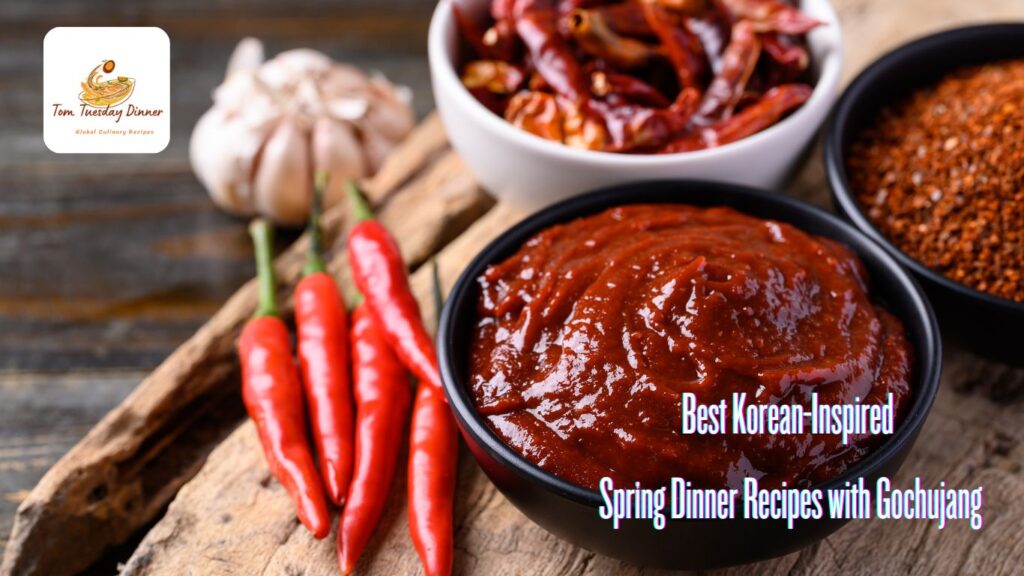We use affiliate links. If you purchase something using one of these links, we may receive compensation or commission.
Introduction to Gochujang
Gochujang is a cornerstone of Korean cuisine that has been gaining popularity worldwide for good reason. This fermented hot pepper paste is made from red chili peppers, glutinous rice, fermented soybeans, and salt, creating a thick condiment with a complex flavor profile that balances heat, sweetness, and umami. Unlike other hot sauces that simply bring heat, gochujang offers depth and richness that can transform ordinary dishes into extraordinary culinary experiences.
As spring arrives with its bounty of fresh produce, it’s the perfect time to incorporate this versatile Korean ingredient into your cooking. The vibrant flavors of gochujang complement the delicate tastes of spring vegetables and lighter proteins, creating meals that are both satisfying and seasonally appropriate.
Spring-Inspired Dinner Recipes
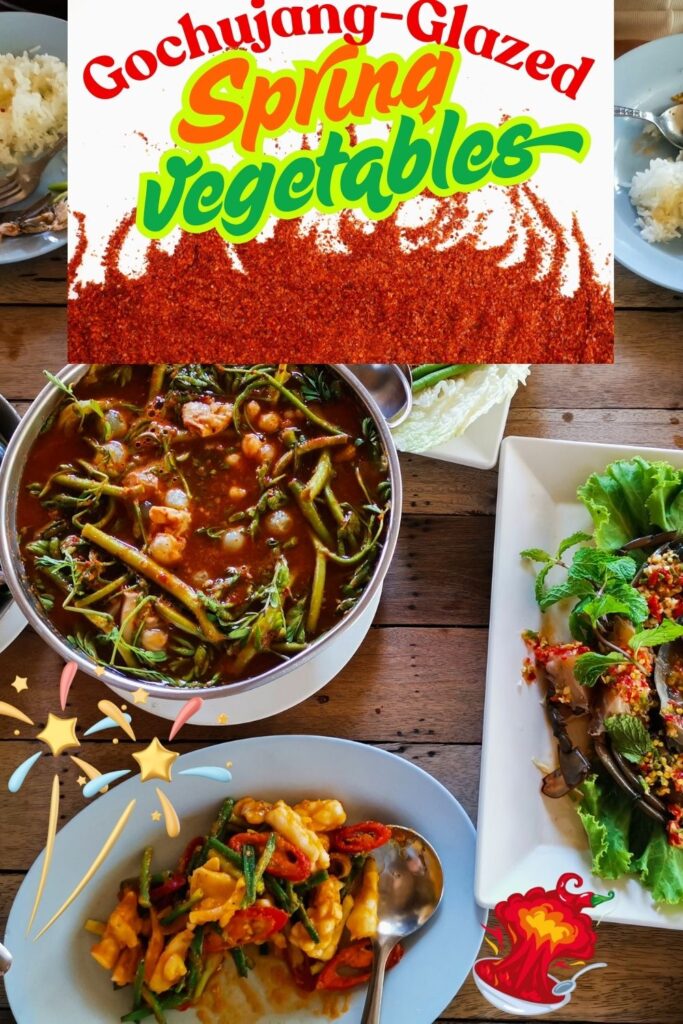
Gochujang-Glazed Spring Vegetable Bowl
Ingredients:
- 2 tablespoons gochujang paste
- 1 tablespoon honey or maple syrup
- 1 tablespoon rice vinegar
- 1 teaspoon sesame oil
- 2 cups cooked brown rice
- 1 bunch asparagus, trimmed
- 1 cup snap peas
- 2 carrots, julienned
- 4 radishes, thinly sliced
- 2 eggs
- 1 tablespoon toasted sesame seeds
- 2 green onions, sliced
Instructions:
- Whisk together gochujang, honey, rice vinegar, and sesame oil in a small bowl to create a glaze.
- Blanch asparagus and snap peas in boiling water for 2 minutes, then shock in ice water.
- Fry eggs sunny-side up or to your preference.
- Arrange rice in bowls and top with blanched and fresh vegetables.
- Place an egg on top of each bowl.
- Drizzle with the gochujang glaze.
- Garnish with sesame seeds and green onions.
Tip: For a protein boost, add thinly sliced grilled chicken or tofu.

Spring Gochujang Noodles with Pea Shoots
Ingredients:
- 8 oz soba or rice noodles
- 3 tablespoons gochujang paste
- 2 tablespoons vegetable oil
- 1 tablespoon soy sauce
- 1 tablespoon honey
- 2 cloves garlic, minced
- 1 tablespoon ginger, grated
- 2 cups pea shoots
- 1 cup mushrooms, sliced
- 1 small zucchini, spiralized or julienned
- Lime wedges for serving
Instructions:
- Cook noodles according to package instructions, drain and rinse with cold water.
- In a small bowl, mix gochujang, soy sauce, honey, garlic, and ginger.
- Heat oil in a large skillet or wok over medium-high heat.
- Add mushrooms and cook until softened, about 3 minutes.
- Add zucchini and stir-fry for 1 minute.
- Add pea shoots and cook just until wilted.
- Add noodles and sauce mixture, tossing to coat evenly.
- Serve hot with lime wedges on the side.
Tip: This dish works well with any spring greens you have on hand—try baby spinach, arugula, or watercress.
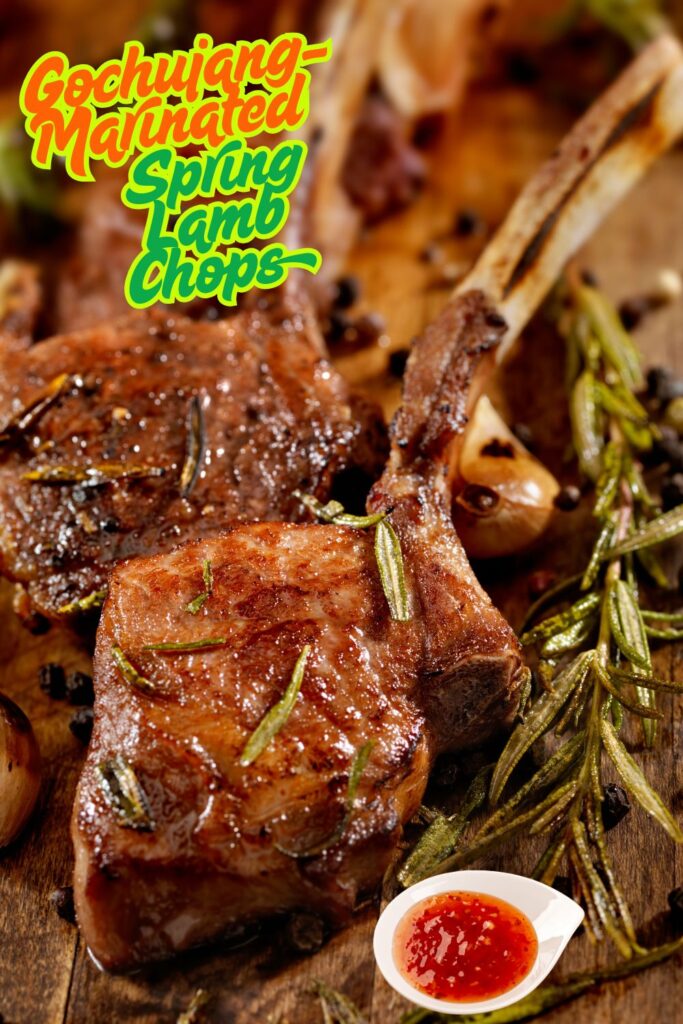
Gochujang-Marinated Spring Lamb Chops
Ingredients:
- 8 lamb chops
- 3 tablespoons gochujang paste
- 2 tablespoons olive oil
- 2 tablespoons rice wine or white wine
- 3 cloves garlic, minced
- 1 tablespoon fresh thyme leaves
- 1 tablespoon honey
- Salt and pepper to taste
- Fresh mint leaves for garnish
Instructions:
- In a bowl, combine gochujang, olive oil, wine, garlic, thyme, and honey.
- Season lamb chops with salt and pepper, then coat with the marinade.
- Refrigerate for at least 2 hours or overnight.
- Remove chops from refrigerator 30 minutes before cooking.
- Preheat grill or grill pan to medium-high heat.
- Grill lamb chops for 3-4 minutes per side for medium-rare.
- Let rest for 5 minutes before serving.
- Garnish with fresh mint leaves.
Tip: If you can’t find lamb, this marinade works beautifully with pork chops or chicken thighs as well.
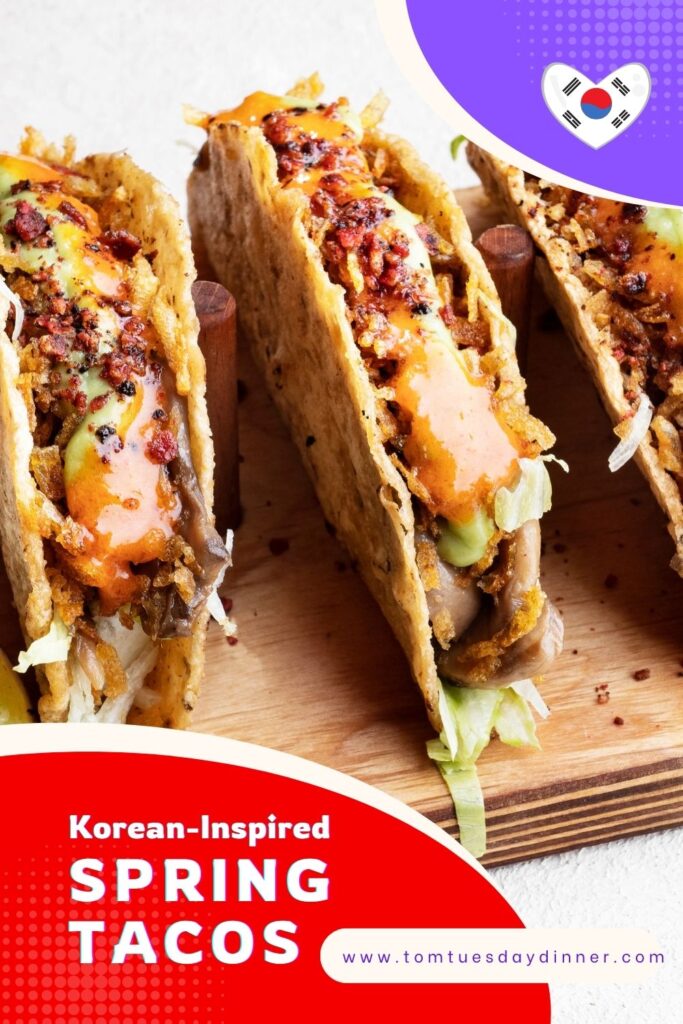
Korean-Inspired Spring Tacos
Ingredients:
- 1 pound flank steak, thinly sliced
- 3 tablespoons gochujang paste
- 2 tablespoons soy sauce
- 1 tablespoon brown sugar
- 2 tablespoons vegetable oil
- 12 small corn or flour tortillas
- 2 cups kimchi, chopped
- 1 cucumber, thinly sliced
- 1 cup radish sprouts or microgreens
- 1/4 cup cilantro leaves
- Lime wedges for serving
For the Gochujang Crema:
- 1/2 cup sour cream or Greek yogurt
- 1 tablespoon gochujang paste
- 1 teaspoon lime juice
- Pinch of salt
Instructions:
- Mix gochujang, soy sauce, and brown sugar in a bowl.
- Add sliced steak and marinate for 30 minutes.
- Mix all crema ingredients and refrigerate until ready to use.
- Heat oil in a large skillet over high heat.
- Cook marinated beef in batches until browned, about 2-3 minutes.
- Warm tortillas on a dry skillet or in the microwave.
- Assemble tacos with beef, kimchi, cucumber, sprouts, and cilantro.
- Drizzle with gochujang crema and serve with lime wedges.
Tip: For a vegetarian version, substitute the beef with sautéed shiitake mushrooms or firm tofu.
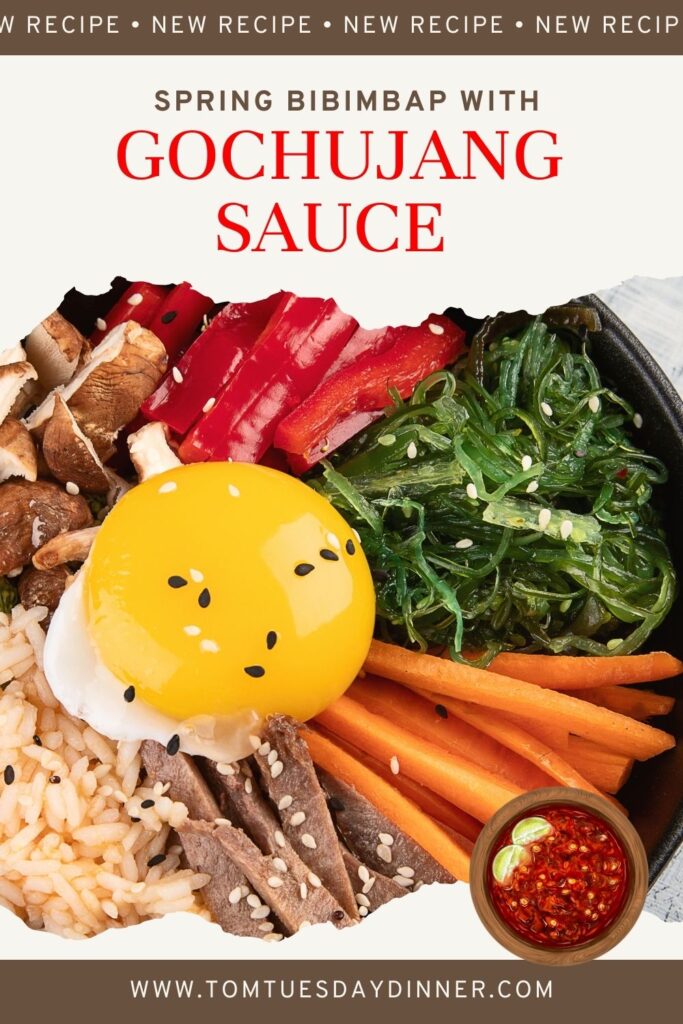
Spring Bibimbap with Gochujang Sauce
Ingredients:
- 2 cups cooked short-grain rice
- 4 tablespoons gochujang paste
- 2 tablespoons sesame oil
- 1 tablespoon sugar
- 1 tablespoon rice vinegar
- 1 clove garlic, minced
- 4 cups mixed spring vegetables (such as spinach, carrots, zucchini, bean sprouts)
- 4 eggs
- 1 tablespoon vegetable oil
- 2 tablespoons toasted sesame seeds
Instructions:
- For the sauce, whisk together gochujang, 1 tablespoon sesame oil, sugar, rice vinegar, and garlic.
- Prepare each vegetable separately: blanch spinach and bean sprouts; sauté julienned carrots and zucchini in remaining sesame oil.
- Fry eggs sunny-side up in vegetable oil.
- Divide warm rice among four bowls.
- Arrange vegetables in separate sections on top of the rice.
- Place a fried egg in the center of each bowl.
- Serve with gochujang sauce on the side.
- Sprinkle with sesame seeds before eating.
Tip: Traditional bibimbap is served in a hot stone bowl (dolsot) which creates a crispy rice crust. If you don’t have one, you can achieve a similar effect by using a cast-iron skillet to crisp the bottom layer of rice before assembling.
Pairing Suggestions
These Korean-inspired spring dishes pair wonderfully with:
- Cold cucumber soup for a refreshing starter
- Chilled barley tea (boricha) or sparkling water with lemon
- Korean rice wine (makgeolli) for an authentic beverage pairing
- Light, crisp white wines like Riesling or Gewürztraminer
- For dessert, fresh fruit or sweet rice cakes (mochi) balance the spicy flavors of the meal
Sourcing Ingredients
Gochujang is increasingly available in mainstream grocery stores in the international foods section. You can also find it in Asian markets or online retailers. If you can’t find gochujang, while not identical, you can create a substitute by mixing miso paste, hot pepper flakes, and a touch of honey or maple syrup.
Spring is all about freshness and new beginnings. These gochujang-inspired recipes bring together the bold, complex flavors of Korean cuisine with the vibrant produce of spring, creating meals that are both comforting and invigorating. Whether you’re new to Korean cooking or a seasoned enthusiast, these dishes offer accessible ways to bring the distinctive taste of gochujang to your spring dinner table.
Spring Bibimbap with Gochujang Sauce
Ingredients:
- 2 cups cooked short-grain rice
- 4 tablespoons gochujang paste
- 2 tablespoons sesame oil
- 1 tablespoon sugar
- 1 tablespoon rice vinegar
- 1 clove garlic, minced
- 4 cups mixed spring vegetables (such as spinach, carrots, zucchini, bean sprouts)
- 4 eggs
- 1 tablespoon vegetable oil
- 2 tablespoons toasted sesame seeds
Instructions:
- For the sauce, whisk together gochujang, 1 tablespoon sesame oil, sugar, rice vinegar, and garlic.
- Prepare each vegetable separately: blanch spinach and bean sprouts; sauté julienned carrots and zucchini in remaining sesame oil.
- Fry eggs sunny-side up in vegetable oil.
- Divide warm rice among four bowls.
- Arrange vegetables in separate sections on top of the rice.
- Place a fried egg in the center of each bowl.
- Serve with gochujang sauce on the side.
- Sprinkle with sesame seeds before eating.
Tip: Traditional bibimbap is served in a hot stone bowl (dolsot) which creates a crispy rice crust. If you don’t have one, you can achieve a similar effect by using a cast-iron skillet to crisp the bottom layer of rice before assembling.
Pairing Suggestions
These Korean-inspired spring dishes pair wonderfully with:
- Cold cucumber soup for a refreshing starter
- Chilled barley tea (boricha) or sparkling water with lemon
- Korean rice wine (makgeolli) for an authentic beverage pairing
- Light, crisp white wines like Riesling or Gewürztraminer
- For dessert, fresh fruit or sweet rice cakes (mochi) balance the spicy flavors of the meal
Sourcing Ingredients
Gochujang is increasingly available in mainstream grocery stores in the international foods section. You can also find it in Asian markets or online retailers. If you can’t find gochujang, while not identical, you can create a substitute by mixing miso paste, hot pepper flakes, and a touch of honey or maple syrup.
Spring is all about freshness and new beginnings. These gochujang-inspired recipes bring together the bold, complex flavors of Korean cuisine with the vibrant produce of spring, creating meals that are both comforting and invigorating. Whether you’re new to Korean cooking or a seasoned enthusiast, these dishes offer accessible ways to bring the distinctive taste of gochujang to your spring dinner table.
🌐 Sources
- streetsmartnutrition.com – 40 Gochujang Recipes with Spicy, Savory Flavor
- webstaurantstore.com – What is Gochujang? – Taste, Uses, Substitutes & More
- wikipedia.org – Barbecue in the United States
- kimchimari.com – 14 Easy Recipes that use Gochujang Sauce
- marionskitchen.com – What IS gochujang and why you should be obsessed with it
- timeout.com – The best barbecue spots in America

